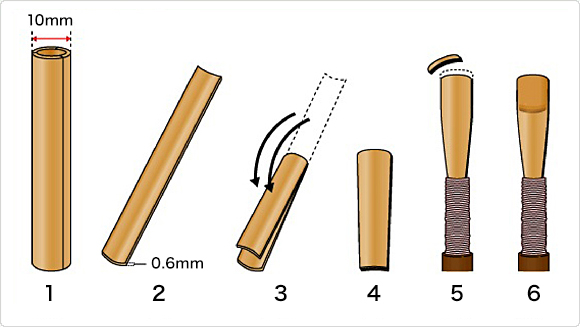How to Play the Oboe
The most attention is paid to the reeds
Players create their own reeds?
Professional oboe players almost always create their own reeds. Finished reeds are available commercially, but they are not necessarily of the player's preferred thickness or shape. Even amateur performers generally create their own reeds.
Even if made with considerable effort, oboe reeds can only be used for somewhere between 10 minutes and a week. Some reeds are completely unusable. Therefore, players have to plan ahead and carefully make a stock of reeds.
This is how reeds are made.
Oboe reeds are made from actual reeds of cane plants. These are split vertically, as in the picture, and the interior is shaved away. The tips are especially important. Because these are the points that vibrate the most while the instrument is being played, they must not be touched by the hands.
The process of making a reed
- A piece of cane with a diameter of about 10 mm is divided vertically into thirds.
- The interior side is shaved down to a thickness of 0.6 mm using a special round planer.
- The reed is folded in half.
- A cutter blade is used to shape the reed like a boat.
- The reed is fastened to the tube with a string, and the end is snipped off.
- The surface is shaved to have a gentle convex shape.

How long do the reeds soak in water?
Oboe reeds are soaked in water before playing so that they have the right level of moisture. They are soaked in lukewarm water for around 2 to 3 minutes. Although some people leave their reeds soaking for 10 minutes or more, this leeches beneficial compounds found in the cane into water, lessening the reed's lifespan, and so is not recommended.
What happens if the reeds open up?
Sometimes reeds will open up wide, such as if they have not been used for a long time, or if the cane used to make them is too thin. In such cases, to avoid cracking, moisten well and then close the reeds by pressing them together with your fingers. Alternatively, wrap a wire around the reeds to adjust the opening.
Because biting down too hard and blowing on reeds with wide openings between them may lead to the teeth cutting into the lips, harm muscles, and impede to mastery, this should be avoided if at all possible.
Small feathers for cleaning reeds
Small feathers are convenient for keeping reeds clean, but in some cases they can damage reeds, so their use is controversial. Because there is a risk of the fibers of the feather digging into the tips of the reeds and fracturing them, avoid utilizing an in-and-out motion. It is better to rotate the feather in such a way that the tip of the feather avoids protruding from between the reeds as much as possible. These small feathers do a better job of cleaning if they are first moistened or if the cleaning is performed submerged.
Musical Instrument Guide:Oboe Contents
Structure
How to Play
How the Instrument is Made
Choosing an Instrument
Trivia
- Why does the oboe lead the orchestra in tuning?
- Do the reeds have a front and a back?
- The keys recoil via springs!
- This is how the oboe and the cor anglais differ
- The charumera was the oboe's cousin
- You can reduce time spent breathing using circular-breathing techniques?
- The Wiener oboe that survived an existential crisis
- Oboe masterpieces: concertos
- Oboe masterpieces: chamber music
- What is the alto oboe?
- The heckelphone, which resembles the oboe
- The oboe is the bassoon's cousin
